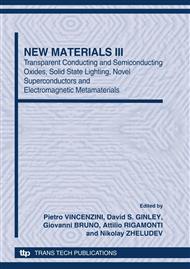[1]
S.F. Yu, Y. Clement, S.P. Lau and H.W. Lee: Appl. Phys. Lett. Vol. 84 (2004), p.3244.
Google Scholar
[2]
Y.M. Strzhemechny, J. Nemergut, P.E. Smith, J. Bae, D.C. Look and L.J. Brillson: J. Appl. Phys. Vol. 94 (2003), p.4256.
Google Scholar
[3]
B. Meyer and D. Marx: J. Phys. Condens. Matter Vol. 15 (2003), p. L89.
Google Scholar
[4]
A. Tsukazaki, M. Kubota, A. Othomo, T. Onuma, K. Ohtani, H. Ohno, S. F. Chichibu, and M. Kawasaki: Jpn. J. Appl. Phys. Vol. 44 (2005), p. L643.
DOI: 10.1143/jjap.44.l643
Google Scholar
[5]
J.L. Lyons, A Janotti, C.G. Van de Walle, Appl. Phys. Lett. 95, 252105 (2009).
Google Scholar
[6]
J. Soohwan, J.J. Chen, F. Ren, H.S. Yang, S. Y. Han, D. P. Norton, S. J. Pearton, J. Vac. Sci. Technol. B 24, 690 (2006).
Google Scholar
[7]
G. Bruno, M. M. Giangregorio, G. Malandrino, P. Capezzuto, I. L. Fragala`, M. Losurdo, Adv. Mater. 21, 1700-1706 (2009).
DOI: 10.1002/adma.200802579
Google Scholar
[8]
Y. Segawa, A. Ohtomo, M. Kawasaki, Z.K. Tang, P. Yu and G.K.L. Wong: Phys. Stat. Sol. B Vol. 202 (1997), p.669.
Google Scholar
[9]
V. Kirilyuk, A.R.A. Zauner, P.C.M. Christianen, J.L. Weyher, P.R. Hageman and P.K. Larsen: Appl. Phys. Lett. Vol. 76 (2000), p.2355.
DOI: 10.1063/1.126344
Google Scholar
[10]
R. Dimitrov, M. Murphy, J. Smart, W. Schaff, J.R. Shealy, L.F. Eastman, O. Ambacher, M. Stutzman: J. Appl. Phys. Vol. 87 (2000), p.3375.
Google Scholar
[11]
C.J. Sun, P. Kung, A. Saxler, H. Ohsato, E. Bigan, M. Razeghi, D.K. Gaskill: J. Appl. Phys. Vol. 76 (1994), p.236.
Google Scholar
[12]
L.K. Li, M.J. Jurkovic, W.I. Wang, J.M. Van Hove P.P. Chow: Appl. Phys. Lett. Vol. 76 (2000), p.1740.
Google Scholar
[13]
M. Losurdo, M. Bergmair, G. Bruno, D. Cattelan, C. Cobet, et al., J Nanopart Res 11, 1521-1554 (2009).
Google Scholar
[14]
T. Wolkenstein, Electronic Processes on Semiconductor Surfaces during Chemisorption, Consultant Bureau-Plenum Publishing Corporation, New York, (1991).
Google Scholar
[15]
M. Kunat, S.G. Girol, T. Becker, U. Burghaus and C. Woll: Phys. Rev. B Vol. 66 (2002), p.081402.
Google Scholar
[16]
G. Kresse, O. Dulub and U. Diebold: Phys. Rev. B Vol. 68 (2003), p.245409.
Google Scholar


